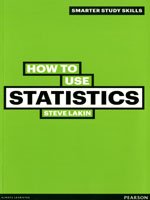How to Use Statistics
By Steve Lakin
August 2011
Pearson Education
Distrubuted by Trans-Atlantic Publications Inc.
ISBN: 9780273743873
283 pages, Illustrated
$28.50 Paper Original
Statistics is arguably the main means through which maths appears in non-maths courses. So many students across a broad range of disciplines encounter statistics, in most cases unexpectedly so, and will need to brush up their skills in order to research, analyse and present their data effectively. Topics such as such as methods of presentation, distributions, confidence limits and so on appear very often – and almost every course involves analysis of data at some point.
De-mystifying the basics for even the most maths-terrified of students, this book will inspire confident and accurate use of statistics for non-maths courses.
Preface and acknowledgements
How to use this book
A note on mathematics, calculators and computer software
Introductory statistics
1. Introduction to statistics and data
2. Presentation of data
3. Averages
4. Cumulative frequencies and percentiles
5. Measures of dispersion
6. Working with frequency distributions
Essential mathematics
7. Factorials, permutations and combinations
8. Sigma notation
Correlation and regression
9. Correlation
10. Linear regression
Probability
11. An introduction to probability
12. Multiple probabilities
13. Probability trees
14. Expected values and decision criteria
15. Conditional probability
Probability distributions
16. Introduction to probability distributions
17. The Poisson distribution
18. The normal distribution
19. The binormal distribution
Hypothesis testing
20. Introduction to hypothesis testing.
21. z-tests
22. t-tests
23. ÷2-tests
24. F-tests. The use of F-tests for comparison of variances
Statistical Tables
Table A - The normal distribution N(0, 1)
Table B - Confidence limits for the z-test
Table C1 - The one-tailed t-test
Table C2 - The two-tailed t-test
Table D - Critical values for the ÷2 distribution
Table E1 - Critical values for the F-test (5%)
Table E2 - Critical values for the F-test (1%)
Summary, glossary and appendices
Summary and further work
Glossary
Appendix 1 - 'Use of a calculator' test
Appendix 2 - The Greek alphabet
Appendix 3 - Some useful Excel commands
Solutions to exercises
Return to main page of Trans-Atlantic Publications